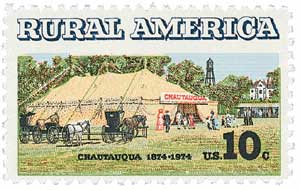
# 1505 FDC - 1974 10c Rural America: Chautauqua Tent
Rural America
Chautauqua Institution

On August 6, 1974, the USPS issued the Chautauqua Institution stamp, the second in the Rural America series, honoring the organization’s centennial.
Reverend John H. Vincent and Lewis Miller of Akron, Ohio, created the Chautauqua Institution in the summer of 1874. Their initial goal was to train Protestant Sunday school teachers in an enjoyable setting.

The first meeting of the institution took place between August 4 and August 18, 1874, on the shores of western New York’s Lake Chautauqua. At the time, it was called the Chautauqua Lake Sunday School Assembly program.

Over time, these assemblies drew the attention of many other people and were eventually opened to the general public. The programs also expanded to include lectures, discussions, and home readings as well as language courses in Hebrew, Greek, French, and German. This summer-school program quickly moved from its original religious orientation to include music, art, and secular education, and offering credit and non-credit courses for adults.

These events also began to draw big names, such as Mark Twain and William Jennings Bryan, who delivered lectures during the eight-week sessions. And every president from Ulysses S. Grant to William McKinley would eventually visit the institute during their tenure.
Soon, the Chautauqua movement spread across the country, with local reading groups forming to discuss current issue. The institute also offered a correspondence course as well as a publishing house and theological school. By the early 1900s, “Chautauqua” became a term for commercial traveling companies who pitched tents and presented lecturers, orators, and performing artists to rural areas.
Over time, these traveling Chautauquas waned in popularity as movies and television became popular forms of entertainment. But the original Chautauqua Institution is still open and offering programs today.

In 1974, the USPS issued a commemorative stamp honoring the centennial of the Chautauqua Institute as part of its Rural America series. The stamp pictures a Chautauqua tent with horses and carriages out front. Stamp designer John Falter had seen a Chautauqua tent in his hometown of Falls City, Nebraska, as a child, and pictured part of the town and its water tower in the stamp’s background.
Click here to visit the Chautauqua Institute’s website for more.
Rural America
Chautauqua Institution

On August 6, 1974, the USPS issued the Chautauqua Institution stamp, the second in the Rural America series, honoring the organization’s centennial.
Reverend John H. Vincent and Lewis Miller of Akron, Ohio, created the Chautauqua Institution in the summer of 1874. Their initial goal was to train Protestant Sunday school teachers in an enjoyable setting.

The first meeting of the institution took place between August 4 and August 18, 1874, on the shores of western New York’s Lake Chautauqua. At the time, it was called the Chautauqua Lake Sunday School Assembly program.

Over time, these assemblies drew the attention of many other people and were eventually opened to the general public. The programs also expanded to include lectures, discussions, and home readings as well as language courses in Hebrew, Greek, French, and German. This summer-school program quickly moved from its original religious orientation to include music, art, and secular education, and offering credit and non-credit courses for adults.

These events also began to draw big names, such as Mark Twain and William Jennings Bryan, who delivered lectures during the eight-week sessions. And every president from Ulysses S. Grant to William McKinley would eventually visit the institute during their tenure.
Soon, the Chautauqua movement spread across the country, with local reading groups forming to discuss current issue. The institute also offered a correspondence course as well as a publishing house and theological school. By the early 1900s, “Chautauqua” became a term for commercial traveling companies who pitched tents and presented lecturers, orators, and performing artists to rural areas.
Over time, these traveling Chautauquas waned in popularity as movies and television became popular forms of entertainment. But the original Chautauqua Institution is still open and offering programs today.

In 1974, the USPS issued a commemorative stamp honoring the centennial of the Chautauqua Institute as part of its Rural America series. The stamp pictures a Chautauqua tent with horses and carriages out front. Stamp designer John Falter had seen a Chautauqua tent in his hometown of Falls City, Nebraska, as a child, and pictured part of the town and its water tower in the stamp’s background.
Click here to visit the Chautauqua Institute’s website for more.









